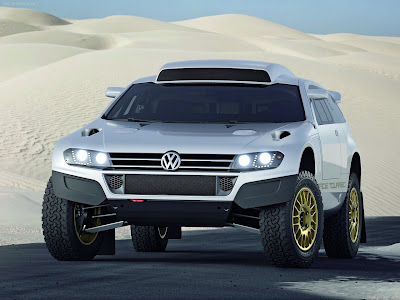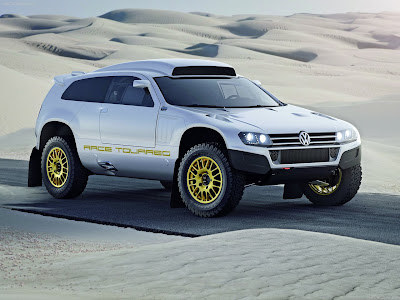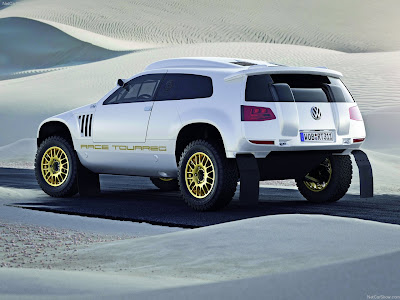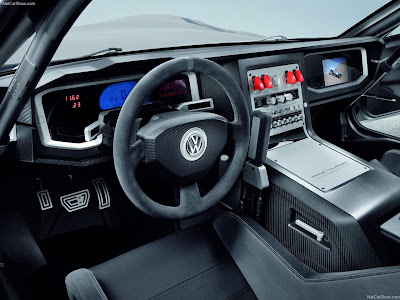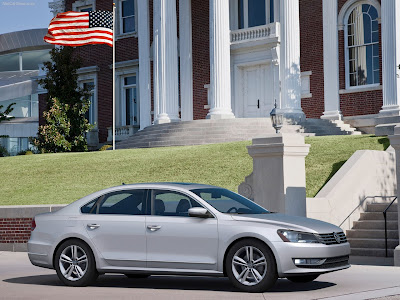








Future mobility is one of the most stimulating topics of our time. The key question here: Just how much could the energy consumption of cars be reduced if all the stops were pulled out for efficiency? There is now an answer to this question, and Volkswagen is delivering it in the form of the new Volkswagen XL1 Concept. Combined fuel consumption: 0.9 l/100 km. No other hybrid car powered by an electric motor / internal combustion engine combination is more fuel efficient. The prototype makes its world debut at the 2011 Qatar Motor Show (26-29 January, 2011).
Conceptually, the Volkswagen XL1 represents the third evolutionary stage of Volkswagen's 1-litre car strategy. When the new millennium was ushered in, Prof. Dr. Ferdinand Piëch, who is today Chairman of the Supervisory Board of Volkswagen AG, formulated the visionary goal of bringing to the market a production car that was practical for everyday use with a fuel consumption of 1.0 litre per 100 km. In the new XL1, Volkswagen is demonstrating that this goal is now within reach.
The new Volkswagen XL1 attains a CO2 emissions value of 24 g/km, thanks to a combination of lightweight construction (monocoque and add-on parts made of carbon fibre), very low aerodynamic drag (Cd 0.186) and a plug-in hybrid system − consisting of a two cylinder TDI engine (35 kW/48 PS), E-motor (20 kW/27 PS), 7-speed dualclutch transmission (DSG) and lithium-ion battery. The results: with fuel consumption of 0.9 l/100 km, the new Volkswagen XL1 only emits 24 g/km CO2. Since it is designed as a plug-in hybrid, the XL1 prototype can also be driven for up to 35 kilometres in pure electric mode, i.e. with zero emissions at point of use. The battery can be charged from a conventional household electric outlet. Naturally, battery regeneration is also employed to recover energy while slowing down and store as much of it as possible in the battery for re-use. In this case, the electric motor acts as an electric generator.
Volkswagen XL1 Concept (2011)
Despite the very high levels of efficiency, developers were able to design a body layout that offers greater everyday practicality, incorporating side by side seating rather than the tandem arrangement seen in both the first 1-litre car presented in 2002 and the L1 presented in 2009. In the new Volkswagen XL1, wing doors make it easier to enter and exit the car. Further progress has been made by manufacturing body parts from carbon fibre reinforced polymer parts (CFRP), a technique used in Formula 1 car construction. Once again, Volkswagen has successfully achieved significant reductions in production costs - an important step forward to make viable a limited production run of the XL1. Background: together with suppliers, Volkswagen has developed and patented a new system for CFRP production in what is known as the aRTM process (advanced Resin Transfer Moulding).
The most efficient car in the world
The new Volkswagen XL1 Concept shows the way forward for extreme economy vehicles and clean technologies. It also demonstrates that such cars can also be fun. The feeling when driving the XL1 is truly dynamic − not based on pure power, rather on its pure efficiency. Two examples:
To travel at a constant speed of 100 km/h, the prototype only needs 6.2 kW/8.4 PS - a fraction of the performance of today's cars (Golf 1.6 TDI with 77 kW and 7-speed DSG: 13.2 kW/17.9 PS).
In electric mode, the Volkswagen XL1 needs less than 0.1 kWh (82 Wh/km) to complete a one kilometre driving course. These are record values.
When the full power of the hybrid system is engaged, the Volkswagen prototype accelerates from 0 to 100 km/h in just 11.9 seconds; its top speed is 160 km/h (electronically limited). Yet these numbers alone do not tell the whole story: Since the XL1 weighs just 795 kg, the drive system has an easy job of propelling the car. When full power is needed, the electric motor, which can deliver 100 Newton metres of torque from a standstill, works as a booster to support the TDI engine (120 Newton metres torque). Together, the TDI and E-motor deliver a maximum torque of 140 Newton metres in boosting mode.
Plug-in hybrid concept
With the new XL1, Volkswagen is implementing a plug-in hybrid concept, which utilises the fuel efficient technology of the common rail turbodiesel (TDI) and the dual clutch transmission (DSG). The TDI generates its stated maximum power of 35 kW/48 PS from just 0.8 litre displacement. The entire hybrid unit is housed above the vehicle's driven rear axle. The actual hybrid module with electric motor and clutch is positioned between the TDI and the 7-speed DSG; this module was integrated in the DSG transmission case in place of the usual flywheel. The integrated lithium-ion battery supplies the E-motor with energy. The high voltage energy flow from and to the battery or E-motor is managed by the power electronics, which operates at 220 Volts. The Volkswagen XL1's body electrical system is supplied with the necessary 12 Volts through a DC/DC converter.
Interplay of E-motor and TDI engine: The E-motor supports the TDI in acceleration (boosting), but as described it can also power the XL1 Concept on its own for a distance of up to 35 km. In this mode, the TDI is decoupled from the drivetrain by disengaging a clutch, and it is shut down. Meanwhile, the clutch on the gearbox side remains closed, so the DSG is fully engaged with the electric motor. Important: The driver can choose to drive the Volkswagen XL1 in pure electric mode (provided that the battery is sufficiently charged). As soon as the electric mode button on the instrument panel is pressed, the car is propelled exclusively by electrical power. Restarting of the TDI is a very smooth and comfortable process: In what is known as "pulse starting" of the TDI engine while driving, the electric motor's rotor is sped up and is very quickly coupled to the engine clutch. This accelerates the TDI to the required speed and starts it. The entire process takes place without any jolts, so the driver hardly notices the TDI engine restarting.
When the XL1 is braked, the E-motor operates as a generator that utilises the braking energy to charge the battery (battery regeneration). In certain operating conditions the load shared between the TDI engine and the electric motor can be shifted so that the turbodiesel is operating at its most favourable efficiency level. The gears of the automatically shifting 7-speed DSG are also always selected with the aim of minimising energy usage. The engine controller regulates all energy flow and drive management tasks, taking into account the power demanded at any given moment by the driver. Some of the parameters used to realise the optimum propulsion mode for the given conditions are: accelerator pedal position and engine load, as well as the energy supply and mix of kinetic and electrical energy at any given time.
Two-cylinder TDI uses mass production technology: The 0.8 litre TDI (35 kW/48 PS) was derived from the 1.6 litre TDI, which drives such cars as the Golf and Passat. The 0.8 TDI exhibits the same data as the 1.6-litre TDI common rail engine in terms of cylinder spacing (88 mm), cylinder bore (79.5 mm) and stroke (80.5 mm). In addition, the Volkswagen XL1 Concept's two-cylinder and the mass produced four cylinder share key internal engine features for reducing emissions. They include special piston recesses for multiple injection and individual orientation of the individual injection jets. The excellent, smooth running properties of the common rail engines were transferred to the two cylinder engine. within addition, a balancer shaft that is driven by the crankshaft turning at the same speed optimises smooth engine running.
Meanwhile, the TDI's aluminium crankcase was constructed to achieve high rigidity and precision, which in turn leads to very low friction losses. With the goal of reducing emissions, exhaust gas recirculation and an oxidation catalytic converter as well as a diesel particulate filter are used. Equipped in this way, the 0.8 TDI already fulfils the limits of the Euro-6 emissions standard.
Also designed for efficiency is the vehicle's cooling system. Engine management only cools the TDI by activating an externally driven electric water pump when engine operating conditions require it. This cooling system includes an automatically controlled air intake system at the front of the vehicle to reduce cooling system drag. This thermal management strategy also contributes towards reduced fuel consumption. A second electric water pump, which is also used only as needed, circulates a separate lower temperature coolant loop to cool the starter generator and power electronics.
CFRP body is a technical masterpiece
The development team made extraordinary strides in designing the CFRP body − in terms of its lightweight construction as well as its aerodynamics. A comparison to the Golf illustrates just how innovative the body concept of the new XL1 is.
The drag coefficient of the highly successful Golf is very good for the compact class: Cd (0.312) x A (frontal area 2.22 m2) equals a total drag figure of 0.693 m2 (Cd.A) providing this car with benchmark aerodynamic credentials in its class. Meanwhile, the Volkswagen XL1 exceeds this performance with a Cd value of 0.186 and a frontal area of 1.50 m2. The product of these two parameters yields a total drag, or Cd.A value of 0.277 m2 which is 2.5 times lower than that of the Golf.
Design for a new era: The VW XL1 is 3,888 mm long, 1,665 mm wide and just 1,156 mm tall. These are extreme dimensions. The Polo has a similar length (3,970 mm) and width (1,682 m), but it is significantly taller (1,462 mm). The height of the new XL1 is about the same as that of a Lamborghini Gallardo Spyder (1,184 mm). So, it is easy to visualise just how spectacular such a Volkswagen would appear on the road - as long and wide as a Polo, but with a low profile like a Lamborghini.
The wing doors of the new Volkswagen XL1 are also reminiscent of a high-end sports car. They are hinged at two points: low on the A-pillars and just above the windscreen in the roof frame, so they do not just swivel upwards, but slightly forwards as well. The doors also extend far into the roof. When they are opened, they free up an exceptionally large amount of entry and exit space.
Visually, the new XL1 also adopts the styling lines of the L1 presented in 2009; however, the new prototype has a more dynamic appearance thanks to its greater width. The design of the entire body was uncompromisingly subjected to the laws of aerodynamics. In front, the VW XL1 Concept exhibits the greatest width; the car then narrows towards the rear. Viewed from above, the form of the XL1 resembles that of a dolphin; especially at the rear, where the lines optimally conform to the air flow over the car body to reduce the Volkswagen's aerodynamic drag.
In side profile, the roofline reflects styling lines that trace an arc from the A-pillar back to the rear. The rear wheels are fully covered to prevent air turbulence; the air flows here are also optimised by small spoilers in front of and behind the wheels. Observers will look for door mirrors in vain; replacing them on the wing doors are small cameras which take on the role of digital outside mirrors that send images of the surroundings behind the car to two displays inside the vehicle.
The front end of the new Volkswagen XL1 Concept no longer exhibits the typical radiator grille; however, it still reflects the styling of the current Volkswagen "design DNA" with a predominance of horizontal lines. Specifically, there is a black cross-stripe (in the area where there is no longer a radiator grille) that combines with the energy-efficient dual LED headlights to form a continuous band. The actual air intake for cooling the TDI engine, battery and interior is located in the lower front end section and has electrically controlled louvres. The narrow turn indicators are also designed in LED technology; these form an "L" shape which vertically follows the wheel housing and horizontally a line beneath the headlights. This creates a front end, which - although it is completely redesigned and extreme in its dimensions - can immediately be recognised as a Volkswagen design by its clean lines.
At the rear, the design takes an entirely new path, reinterpreting the brand values of precision and quality. A new dimension of Volkswagen styling was created here. Four characteristics are discernible:
Once again, the dolphin body form that narrows towards the rear with very precise trailing edges for perfect aerodynamics.
The coupé-shaped roofline without rear windscreen. Merging into the roofline is the large rear boot lid that covers the drive unit and 100 litre luggage space.
A strip of red LEDs that frames the rear section at the top and on the sides. Integrated in this LED strip are the reversing lights, rear lights, rear fog lights and brake lights.
A black diffuser, which exhibits nearly seamless transitions to the completely covered underbody.
Lightweight construction: more systematic than ever: Large sections of the new XL1's body consist of carbon fibre reinforced polymer (CFRP) − which is as lightweight as it is strong. Specifically, the monocoque with its slightly offset seats for driver and passenger and all exterior body parts are made of CFRP. The layers of carbon fibre, which are aligned with the directions of forces, are formed into parts with an epoxy resin system in the aRTM process. This material mix produces an extremely durable and lightweight composite. For a long time, it was considered impossible to manufacture a body of CFRP, like that of the new Volkswagen XL1 Concept, to industrial standards. Nonetheless, Volkswagen successfully found a cost-effective way to mass produce CFRP parts in sufficient volumes as early as 2009 - in the framework of the XL1 development project. Now this process has been further perfected.
CFRP is the ideal material for the body of the new XL1 because of its light weight. The XL1 Concept weighs only 795 kg. Of this figure, 227 kg represents the entire drive unit, 153 kg the running gear, 80 kg the equipment (including the two bucket seats) and 105 kg the electrical system. That leaves 230 kg, which is precisely the weight of the body - produced largely of CFRP − including wing doors, front windscreen in thin-glass technology as in motorsport and the highly safe monocoque. A total of 21.3 percent of the new Volkswagen XL1, or 169 kg, consists of CFRP. In addition, Volkswagen uses lightweight metals for 22.5 percent of all parts (179 kg). Only 23.2 percent (184 kg) of the new XL1 is constructed from steel and iron materials. The rest of its weight is distributed among various other polymers (e.g. polycarbonate side windows), metals, natural fibres, process materials and electronics.
Lightweight construction: safer than ever: The new XL1 is not only lightweight, but very safe as well. As mentioned, this is due in part to the use of CFRP as a material. In the style of Formula 1 race cars, the Volkswagen has a high-strength monocoque. In contrast to Formula 1, however, this safety capsule is enclosed on top - for safety. Depending on the type of collision, the load path may be directed through the A- and B-pillars, cant rails and sills, all of which absorb the impact energy. Additional side members and crossmembers in the front and rear perfect the car's passive safety.
Running gear with ESP utilises high-tech materials
The running gear is equipped with anti-roll bars at the front and rear and is characterised by lightweight construction with maximum safety. In front, a double wishbone suspension is used, while a semi-trailing link system is employed at the rear. The front and rear suspension are both very compact in construction and offer a high level of driving comfort. The running gear components mount directly to the CFRP monocoque in key areas.
Running gear weight has been reduced by the use of aluminium parts (including suspension components, brake calipers, dampers, steering gear housing), CFRP (anti-roll bars), ceramics (brake discs) magnesium (wheels) and plastics (steering wheel body). Friction-optimised wheel bearings and drive shafts, as well as an entirely new generation of optimised low rolling resistance tyres from MICHELIN (front: 115/80 R 15; rear: 145/55 R 16), contribute to the low energy consumption of the Volkswagen XL1 Concept. Safety gains are realised by an anti-lock braking system (ABS) and electronic stabilisation programme (ESP). That is because sustainability without maximum safety would not really be a step forward. The new VW XL1 shows how these two parameters can be brought into harmony.
